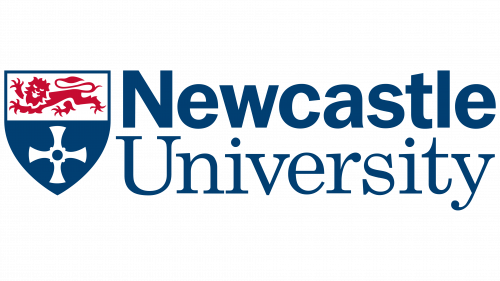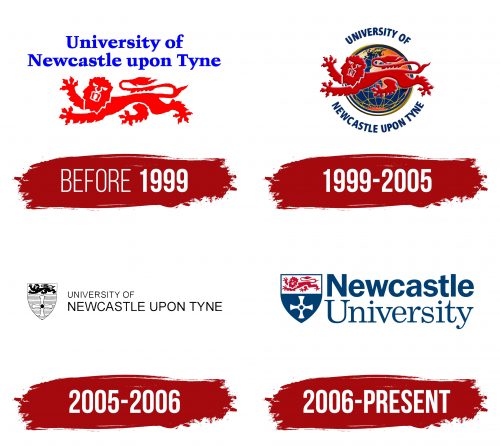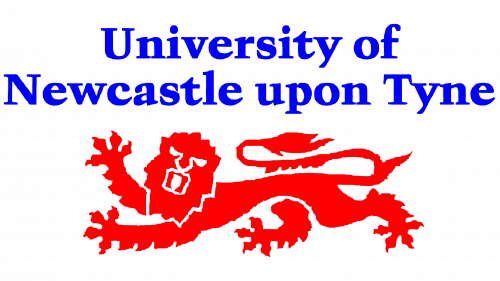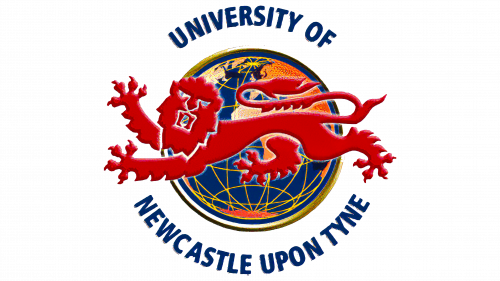The Newcastle University logo is designed in the strict traditions of English heraldry, emphasizing the university’s commitment to a classical style and demonstrating the high level of its educational programs. These programs are built on a solid foundation of many years of experience, reflecting a serious approach to education and respect for tradition.
Newcastle University: Brand overview
The School of Medicine and Surgery was established in Newcastle upon Tyne in 1834, marking the beginning of Newcastle University’s existence. The rapidly expanding industrial region of northeast England was experiencing a shortage of qualified medical practitioners, which prompted the establishment of this hospital.
The School of Practical Science and Engineering was established in 1851 and played a major role in its development. This institution aimed to educate experts in the mining and engineering domains, which are vital for the area’s coal mining and heavy industry-driven economy.
A significant event occurred in 1871 when Durham University and the School of Medicine and Surgery combined to form the Durham College of Medicine. This union increased the institution’s capacity and enhanced its standing as an academic institution.
The Durham College of Science was established in 1883 when the university merged with the School of Practical Science and Engineering. This combination reinforced the scientific foundation and increased the educational programs’ breadth.
An important turning point in the institution’s history occurred in 1937. Following their merger, the two colleges—Medicine and Science—formed King’s College, Newcastle, which expanded its autonomy while staying a part of Durham University.
The post-war era was marked by King’s College’s explosive growth and development. In response to society and the economy’s expanding demands, new faculties were founded, such as the Faculty of Agriculture in 1947 and the Faculty of Dentistry in 1948.
The institution’s history underwent a sea change in 1963. Following its separation from the parent university, King’s College, Newcastle became the University of Newcastle upon Tyne. This event marked the beginning of the university’s era as an independent entity.
The institution continued to grow during the 1960s and 1970s. The Faculty of Law was founded in 1965, and the School of Architecture followed in 1970, among other new faculties and research areas. The student campus substantially grew during this time, and new academic buildings and labs were built.
Research efforts increased during the 1980s and 1990s. In 1989 and 1992, the Institute of Human Genetics and the Center for Urban and Regional Development Studies were founded as new research institutes.
The university began its international expansion in 2000 when it launched its first campus abroad in Malaysia. This action greatly increased the university’s global reach and attracted additional international students.
In 2006, the official name was changed to Newcastle University in recognition of the institution’s expanding global reach.
The Centre for Life Sciences was established in 2008 and has become a significant biomedical innovation and research center.
In 2010, the university’s international reputation was enhanced by opening a new campus in Singapore.
The school celebrated its 180th anniversary in 2015, solidifying its place among the oldest and most prestigious universities in the United Kingdom.
In 2017, the university expanded its presence in the capital city of London by building a new urban campus, offering students additional opportunities.
The Frederick Douglass Center for Data Innovation was established by the University of London in 2018. This center improved the university’s standing in digital technology by concentrating on big data and artificial intelligence research.
The ambitious “Vision 2025” program was introduced in 2019 to raise the standard of research and education even further. The initiative included plans to increase multidisciplinary research and boost the university’s international clout.
The Center for Urban Science and Progress opened its doors that same year. It concentrates on applying cutting-edge technology and research to address contemporary urban problems.
Despite global challenges, the institution made large investments in its digital infrastructure in 2020 and expanded the scope of its virtual research and online learning offerings.
In 2021, the institution introduced a new research and innovation plan to use multidisciplinary cooperation to address global concerns.
A brand-new Center for Creative Arts opened its doors in 2021, offering cutting-edge facilities to students studying creative fields.
The growth of global cooperation distinguished the year 2022. The institution recently inked several collaboration agreements with eminent universities worldwide, creating new opportunities for collaborative research initiatives and student exchanges.
That same year, a new initiative was started to build the cutting-edge Helix campus and create an ecosystem for startups and technology enterprises.
The university’s standing in materials science and nanotechnology was enhanced in 2023 with the inauguration of a new Center for Advanced Materials.
During this time, the institution maintained its rise in national and international rankings, especially in engineering, social sciences, and medical research.
As part of its increased efforts to support students, the school also improved student mental health and well-being services and increased the scope of its scholarship and grant programs.
The institution kept enhancing its research capabilities, concentrating especially on digital technology, sustainable development, and healthy aging.
Meaning and History
What is Newcastle University?
Newcastle upon Tyne, England, is home to the Newcastle Institute, an outstanding public research institution. Known for its impact on research and the quality of education, the university offers a wide range of undergraduate and postgraduate programs in the humanities, social sciences, engineering, natural sciences, health sciences, and other fields. It is particularly known for its digital technology, health, and sustainability achievements. The University has a distinguished past and an exciting modern campus in Newcastle’s center. With a strong emphasis on industry contacts and employability, the university offers students real-world experience and career development opportunities. The university’s extensive international network and diverse international student body testify to its global outlook.
Before 1999
The institution’s first logo was closely associated with the lion symbol, depicted on the flag of the United Kingdom. The lion, which has accompanied national flags since before the reign of Richard the Lionheart, emphasized the national identity embedded in the foundation of the School of Medicine and Surgery, which later became a college and university.
Above the lion image was the blue inscription “University of Newcastle upon Tyne,” indicating the name of the city where the university is located. The institution was founded in 1963 after the separation of King’s College, Durham; thus, the emblem was created no earlier than this date. The combination of red and blue colors further strengthened the association of the image with England’s national symbols.
1999 – 2005
The university emblem retained the image of the lion, symbolizing national pride, and placed it against the backdrop of a globe. Around the globe, the university’s name is positioned, emphasizing the idea of globalization and expansion. The university actively developed programs to attract international students and strengthen connections with global academic and scientific institutions. This process included creating exchange programs and collaborations with universities worldwide. The globe symbolizes the university’s ambition for a global presence and its goals. The traditional blue and red colors are also preserved in the emblem.
2005 – 2006
The emblem was transformed into a combination of an image and the university’s name. The shield symbolizes nobility and embodies global heraldic traditions. The image evokes associations with knighthood, pure intentions, and a readiness to defend the truth.
The university’s shield features two symbols of England: the lion and the cross of Saint George. The lion represents respect for the monarchy, highlighting the university’s historical heritage as a Royal College. The cross symbolizes faith and the pursuit of truth, and it is associated with Richard the Lionheart’s adoption during the Crusades.
The university’s name is placed on the right side of the emblem. A distinctive feature of the symbol is its black-and-white color scheme.
2006 – today
The Newcastle University logo was updated, gaining modern features and a brighter color scheme. The focus is now on the emblem, which features a shield with two main symbols: a red lion at the top and a white cross at the bottom. The shield represents strength and protection, while the red lion is associated with courage and bravery, rooted in the heraldic traditions of the region. The white cross on a blue background symbolizes a connection to Christianity and the historical role of this symbol in northeast England.
The university’s name was shortened to “Newcastle University” and split into two levels. The word “Newcastle” is bolded, emphasizing the city’s importance in the educational institution. The design’s predominance of blue shades highlights logic, science, and intellectual development, reflecting the university’s programs’ core values and focus areas.
This combination of elements and colors in the logo gives the university a modern and professional look while maintaining a connection to its historical heritage and traditions.
The Seal
The Newcastle University seal is a more condensed version of the logo, embodying symbols significant to the university’s identity and mission. The central element of the seal is a triangular shield, symbolizing the strength of convictions and the fundamental truths taught at the university.
At the top of the shield is a red lion, echoing the image of the English flag. The lion represents strength, courage, and nobility—qualities the university prides itself on and aims to instill in its students.
The lower part of the shield contains a white cross on a blue background, resembling an award or order. This cross symbolizes the university’s contribution to the advancement of science and its role in promoting intellectual progress both in the UK and internationally.
Like the logo, the university seal combines historical symbols with modern values, emphasizing the pursuit of academic excellence and a commitment to tradition.









